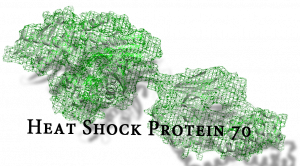 The heat shock protein 70 (Hsp70) molecular chaperones are found ubiquitously in the cell and they have many important functions for cell survival; such as to prevent aggregation, fold nascent protein chains, aid translocation across cellular membranes, and assist in protein degradation. Hsp70s are constitutively expressed in all types of cells; also their expression can be enhanced by stress factors. Hsp70s are a conserved family of proteins that consist of an N-terminal ATPase domain and a C-terminal substrate-binding domain. ATP binding leads to reduced substrate-binding affinity for Hsp70s, and reciprocally, substrate-binding activates their ATPase rates. This interdomain communication is essential for Hsp70 chaperone function. Unfortunately, yet the lack of available structural information of full-length Hsp70s at different ligand-bound states limit our understanding for the allosteric signaling mechanism. With this project, we aim to understand the structural details of the signaling mechanism of DnaK, E. coli Hsp70, by the application of genetic engineering methods in combination with various biophysical and biochemical techniques. We also employ computational methods to our studies in order to better understand the molecular details of the signaling mechanism.
The heat shock protein 70 (Hsp70) molecular chaperones are found ubiquitously in the cell and they have many important functions for cell survival; such as to prevent aggregation, fold nascent protein chains, aid translocation across cellular membranes, and assist in protein degradation. Hsp70s are constitutively expressed in all types of cells; also their expression can be enhanced by stress factors. Hsp70s are a conserved family of proteins that consist of an N-terminal ATPase domain and a C-terminal substrate-binding domain. ATP binding leads to reduced substrate-binding affinity for Hsp70s, and reciprocally, substrate-binding activates their ATPase rates. This interdomain communication is essential for Hsp70 chaperone function. Unfortunately, yet the lack of available structural information of full-length Hsp70s at different ligand-bound states limit our understanding for the allosteric signaling mechanism. With this project, we aim to understand the structural details of the signaling mechanism of DnaK, E. coli Hsp70, by the application of genetic engineering methods in combination with various biophysical and biochemical techniques. We also employ computational methods to our studies in order to better understand the molecular details of the signaling mechanism.
